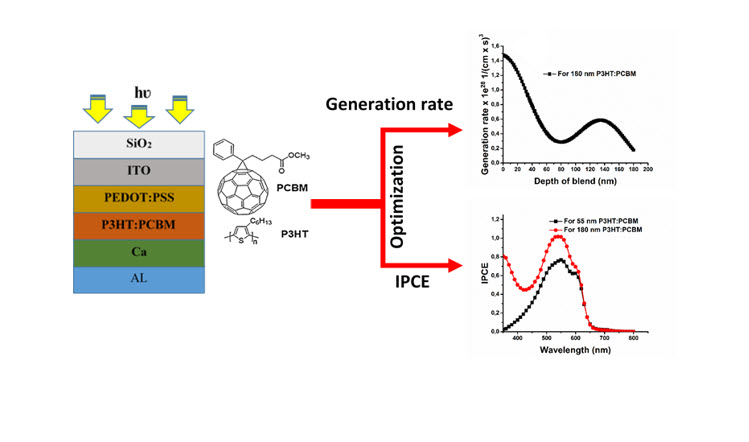Wed, Feb 5, 2025
[Archive]
Volume 21, Issue 2 (June 2024)
IJMSE 2024, 21(2): 145-150 |
Back to browse issues page
Download citation:
BibTeX | RIS | EndNote | Medlars | ProCite | Reference Manager | RefWorks
Send citation to:



BibTeX | RIS | EndNote | Medlars | ProCite | Reference Manager | RefWorks
Send citation to:
Brioua F, Daoudi C. Optimizing Organic Solar Cells: The Effect of P3HT:PCBM Active Layer and Ca Interference Layer. IJMSE 2024; 21 (2) :145-150
URL: http://ijmse.iust.ac.ir/article-1-3462-en.html
URL: http://ijmse.iust.ac.ir/article-1-3462-en.html
Abstract: (10117 Views)
We have modeled theoretical incident photon-to-current electricity (IPCE) action spectra of poly(3-hexylthiophene) (P3HT) and [6,6]-Phenyl C61 butyric acid methyl ester active layer bulk-heterojunction. By the two-dimensional optical model of a multilayer system based on the structure of Glass substrate / SiO2 /ITO/ PEDOT: PSS /P3HT: PCBM(1:1)/Ca/Al, the optical responses of the device have been computed for different photoactive layer and Ca layer thicknesses to found an optimal structure which allows obtaining the maximum absorption localized in the active layer and high device performance. The electric field intensity, energy dissipation, generation rate, and IPCE have been computed to enhance the device's performance. The finite element method executes the simulation under an incident intensity of 100 mW/cm2 of the 1.5 AM illumination. It was found that the optimum structure is achieved by a 180 nm photoactive layer and 5 nm Ca layer thicknesses.
Type of Study: Research Paper |
Subject:
Synthesis and preparation of materials to meet the requirements of AM techniques
Send email to the article author
| Rights and permissions | |
 |
This work is licensed under a Creative Commons Attribution-NonCommercial 4.0 International License. |








